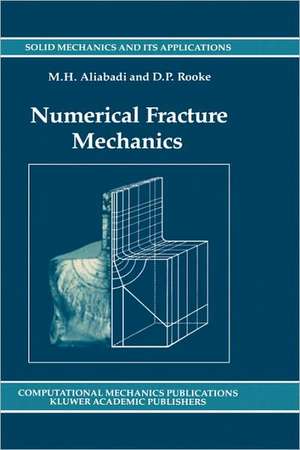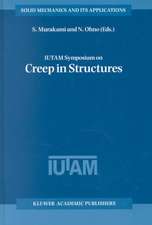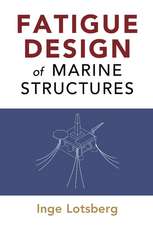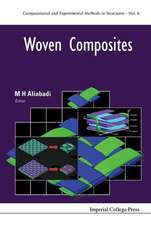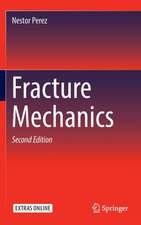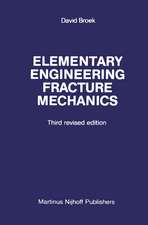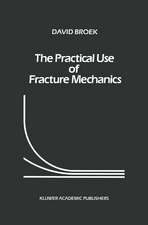Numerical Fracture Mechanics: Solid Mechanics and Its Applications, cartea 8
Autor M. H. Aliabadi, D.P. Rookeen Limba Engleză Hardback – 31 iul 1991
| Toate formatele și edițiile | Preț | Express |
|---|---|---|
| Paperback (1) | 1380.02 lei 6-8 săpt. | |
| SPRINGER NETHERLANDS – 23 oct 2012 | 1380.02 lei 6-8 săpt. | |
| Hardback (1) | 1386.17 lei 6-8 săpt. | |
| SPRINGER NETHERLANDS – 31 iul 1991 | 1386.17 lei 6-8 săpt. |
Din seria Solid Mechanics and Its Applications
- 20%
 Preț: 698.09 lei
Preț: 698.09 lei - 24%
 Preț: 800.14 lei
Preț: 800.14 lei -
 Preț: 402.14 lei
Preț: 402.14 lei - 15%
 Preț: 640.06 lei
Preț: 640.06 lei - 15%
 Preț: 653.14 lei
Preț: 653.14 lei - 18%
 Preț: 1124.92 lei
Preț: 1124.92 lei - 15%
 Preț: 643.84 lei
Preț: 643.84 lei - 18%
 Preț: 1119.38 lei
Preț: 1119.38 lei - 20%
 Preț: 573.17 lei
Preț: 573.17 lei - 18%
 Preț: 1607.92 lei
Preț: 1607.92 lei - 17%
 Preț: 393.72 lei
Preț: 393.72 lei - 17%
 Preț: 459.40 lei
Preț: 459.40 lei - 18%
 Preț: 959.98 lei
Preț: 959.98 lei - 18%
 Preț: 747.71 lei
Preț: 747.71 lei -
 Preț: 388.55 lei
Preț: 388.55 lei - 18%
 Preț: 787.15 lei
Preț: 787.15 lei -
 Preț: 406.25 lei
Preț: 406.25 lei - 15%
 Preț: 639.08 lei
Preț: 639.08 lei - 24%
 Preț: 784.82 lei
Preț: 784.82 lei - 15%
 Preț: 643.34 lei
Preț: 643.34 lei - 18%
 Preț: 958.07 lei
Preț: 958.07 lei - 18%
 Preț: 1228.15 lei
Preț: 1228.15 lei - 18%
 Preț: 734.27 lei
Preț: 734.27 lei - 18%
 Preț: 1233.06 lei
Preț: 1233.06 lei - 18%
 Preț: 1236.19 lei
Preț: 1236.19 lei - 18%
 Preț: 950.96 lei
Preț: 950.96 lei - 18%
 Preț: 906.48 lei
Preț: 906.48 lei - 18%
 Preț: 964.54 lei
Preț: 964.54 lei - 20%
 Preț: 995.75 lei
Preț: 995.75 lei - 18%
 Preț: 953.65 lei
Preț: 953.65 lei - 18%
 Preț: 1239.67 lei
Preț: 1239.67 lei - 18%
 Preț: 962.35 lei
Preț: 962.35 lei - 18%
 Preț: 964.54 lei
Preț: 964.54 lei - 18%
 Preț: 913.11 lei
Preț: 913.11 lei - 18%
 Preț: 1226.90 lei
Preț: 1226.90 lei
Preț: 1386.17 lei
Preț vechi: 1690.45 lei
-18% Nou
Puncte Express: 2079
Preț estimativ în valută:
265.24€ • 277.68$ • 219.47£
265.24€ • 277.68$ • 219.47£
Carte tipărită la comandă
Livrare economică 08-22 aprilie
Preluare comenzi: 021 569.72.76
Specificații
ISBN-13: 9780792311751
ISBN-10: 0792311752
Pagini: 276
Ilustrații: X, 276 p.
Dimensiuni: 155 x 235 x 18 mm
Greutate: 0.59 kg
Ediția:1991
Editura: SPRINGER NETHERLANDS
Colecția Springer
Seria Solid Mechanics and Its Applications
Locul publicării:Dordrecht, Netherlands
ISBN-10: 0792311752
Pagini: 276
Ilustrații: X, 276 p.
Dimensiuni: 155 x 235 x 18 mm
Greutate: 0.59 kg
Ediția:1991
Editura: SPRINGER NETHERLANDS
Colecția Springer
Seria Solid Mechanics and Its Applications
Locul publicării:Dordrecht, Netherlands
Public țintă
ResearchCuprins
1. Basic Fracture Mechanics.- 1.1 Introduction.- 1.2 Energy balance.- 1.3 Stress intensity factors.- 1.4 Residual strength.- 1.5 Fatigue crack growth.- 1.6 Stress corrosion cracking.- 1.7 Limitations (plasticity).- 1.8 Residual stress effects.- 1.9 Concluding remarks.- 1.10 Bibliography.- 1.11 References.- 2. Development of Fracture Mechanics Analysis.- 2.1 Introduction.- 2.2 Basic equations of elasticity.- 2.3 Airy stress functions.- 2.4 Muskhelishvili’s complex functions.- 2.5 Complex stress function analysis.- 2.6 Westergaard’s stress function.- 2.7 William’s eigenfunction series expansion.- 2.8 Papkovich-Neuber potentials.- 2.9 The energy principle.- 2.10 Elastic-plastic fracture.- 2.11 Three-dimensional stress field.- 2.12 Mixed mode fracture.- 2.13 Concluding remarks.- 2.14 References.- 3. Numerical Methods in Linear Elastic Fracture Mechanics.- 3.1 Introduction.- 3.2 Superposition.- 3.3 Stress concentrations.- 3.4 Local stress distributions.- 3.5 Green’s functions/Weight functions.- 3.6 Compounding method.- 3.7 Boundary collocation methods.- 3.8 Integral transforms/continuous dislocations.- 3.9 Body force method.- 3.10 Method of lines.- 3.11 Edge function method.- 3.12 Finite element method.- 3.13 Alternating technique.- 3.14 Concluding remarks.- 3.15 References.- 4. The Boundary Element Method.- 4.1 Introduction.- 4.2 The boundary element formulation in elasticity.- 4.3 Fundamental solutions.- 4.4 Numerical discretization.- 4.5 Assembly of system of equations.- 4.6 Stress and displacement at interior points.- 4.7 Numerical evaluation of coefficient matrices.- 4.8 Evaluation of boundary stresses.- 4.9 Multi-domain formulation.- 4.10 Body force.- 4.11 Concluding remarks.- Appendix A Betti’s reciprocal theorem.- Appendix B Evaluation of the free term Cijfor smooth boundaries.- Appendix C Evaluation of local boundary stresses.- 4.12 References.- 5. Application of Boundary Element Methods to Fracture Mechanics.- 5.1 Introduction.- 5.2 Difficulties in crack modelling.- 5.3 Crack-tip elements.- 5.4 Crack Green’s function.- 5.5 Displacement discontinuity method.- 5.6 Energy method.- 5.7 J-integral.- 5.8 Subtraction of singularity.- 5.9 Concluding remarks.- 5.10 References.- 6. Weight Function Techniques.- 6.1 Introduction.- 6.2 Basic principles of Green’s functions.- 6.3 Stress intensity factors as Green’s functions.- 6.4 Systematic use of Green’s functions.- 6.5 Available Green’s functions.- 6.6 Weight functions.- 6.7 Numerical weight functions.- 6.8 Approximate weight functions.- 6.9 Application of the BEM to weight functions.- 6.10 Weight functions for strip yield cracks.- 6.11 Weight functions for residual stress fields.- 6.12 Concluding remarks.- Appendix A Closed form weight functions.- Appendix B Three-dimensional stress and displacement fields for a semi-infinite crack.- Appendix C Near-tip displacement and stress fields.- 6.13 References.
